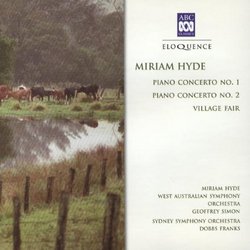| All Artists: Hyde, West Aus Sym Orch, Simon Title: Hyde: Pno Ctos Nos 1 & 2 / Village Fair Members Wishing: 0 Total Copies: 0 Label: ABC Classics Original Release Date: 1/1/2002 Re-Release Date: 1/28/2002 Album Type: Import Genre: Classical Style: Number of Discs: 1 SwapaCD Credits: 1 UPC: 028946573525 |
Search - Hyde, West Aus Sym Orch, Simon :: Hyde: Pno Ctos Nos 1 & 2 / Village Fair
 | Hyde, West Aus Sym Orch, Simon Hyde: Pno Ctos Nos 1 & 2 / Village Fair Genre: Classical
|
Larger Image |
CD DetailsSimilar CDs |
CD ReviewsBeautiful Guna | DELHI, India | 06/20/2005 (5 out of 5 stars) "Miriam Hyde (1913-2005) is one of Australia's foremost musical names as a composer, pianist, teacher and examiner. During her life she wrote a large amount of music in genres including orchestral, choral, vocal, chamber music and a long list of solo piano works, in predominantly a lyrical post-Romantic to Impressionist style. Personally I think her chamber music is of the highest quality of all, and a double CD set can be found on Walsingham Classics (sadly not sold on this site).
Miriam Hyde's two piano concertos, written while she was studying in England, are wonderful works. The first is very characteristic of Rachmaninoff. A bouyant dotted rhythm pervades the first movement, and the strong opening in the strings followed by a piano cadenza spanning the whole keyboard reminds us of the Grieg A minor or the Rachmaninoff F# minor concertos. The opening material alternates between plaintive and discontented in mood, chromatic with frequent modulations (typical of her style). The second theme is very beautiful, much more sustained and lyrical, making heavy use of chromatic colorations for emotional effect. The second movement is more chromatic than the first, and fantasy-like in form. The principal theme uses chromatic motion, the phrases alternating between piano and orchestra, before an exquisite sighing melody appears on the strings... sheer poetry! The third movement has obvious references to the first, but transformed in a driving rhythm. Much earlier material appears here, transformed. The last section, where the rhythm becomes dotted and the tempo picks up, is memorable. The second concerto is more adventurous, less traditional. It opens with a very majestic, warlike passage on the brass, with very evocative harmonic passages. This theme appears in many guises. The second theme, given out on piano in high register, has a beautiful plaintive touch with the leap of a 6th along with the diminished 7th chord. The second movement is a poeme, free in form, brimming with expressive melodies and chromatic progressions, much like the style of Delius or Wagner's Tristan and Isolde. The piano's water-like descending sequence of chords, appearing several times in the movement, delicately rounds off several orchestral passages, and in the end the whole movement. The lyrical themes and dramatic climaxes in this movement are exquisite. The third movement theme is on pentatonic scale, and very folk-like in mood, on top of bouyant rhythm. In the end, the theme is transformed to simple duple time, and mixolydian mode in the tonic major key, leading up to a triumphant ending. Village Fair was originally written as music to a ballet, but serves here as an evocative tone-poem. The theme "Oh dear, what can the matter be?" is the basis for this work, and this theme appears very explicitly twice; the majestic opening theme and several subsequent themes are disguised versions of this. This work is a gem, using orchestral colours for excellent effect. Miriam Hyde herself performs the concertos brilliantly and expressively, and the orchestras both interpret her works very well. Miriam Hyde did write very beautifully, and this CD is rediculously cheap - especially with the composer herself performing! Strongly recommended. Five stars." |

 Track Listings (3) - Disc #1
Track Listings (3) - Disc #1